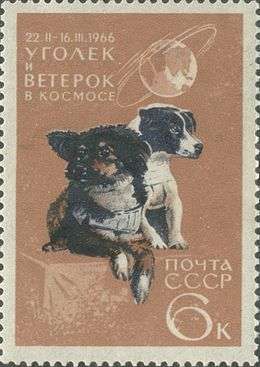Kosmos 110
 | |
| Mission type | Biosciences |
|---|---|
| Operator | OKB-1 |
| COSPAR ID | 1966-015A |
| SATCAT № | 2070 |
| Spacecraft properties | |
| Spacecraft | Vostok-3KV No.5 |
| Launch mass | 5,700 kilograms (12,600 lb) |
| Start of mission | |
| Launch date | 22 February 1966, 20:09:36 UTC |
| Rocket | Voskhod |
| Launch site | Baikonur 31/6 |
| End of mission | |
| Landing date | 16 March 1966, 14:09:00 UTC |
| Orbital parameters | |
| Reference system | Geocentric |
| Regime | LEO |
| Eccentricity | 0.05001 |
| Perigee | 190 kilometres (120 mi) |
| Apogee | 882 kilometres (548 mi) |
| Inclination | 51.85° |
| Period | 89.2 minutes |
Kosmos 110 (Russian: Космос 110 meaning Cosmos 110) was a Soviet spacecraft launched on 22 February 1966 from the Baikonur Cosmodrome aboard a Voskhod rocket.
Mission
It incorporated a re-entry body (capsule) for landing scientific instruments and test objects. It was a biological satellite that made a sustained biomedical experiment through the Van Allen radiation belts with the dogs Veterok and Ugolyok, after 22 days in orbit around the Earth, they were safely landed.[1]
This spaceflight of record-breaking duration was not surpassed by humans until Soyuz 11 in June 1971 and still stands as the longest space flight by dogs.
Details
Other Names
- 02070
See also
References
- ↑ NASA National Space Science Data Center: Cosmos 110
This article is issued from Wikipedia - version of the 6/11/2016. The text is available under the Creative Commons Attribution/Share Alike but additional terms may apply for the media files.
